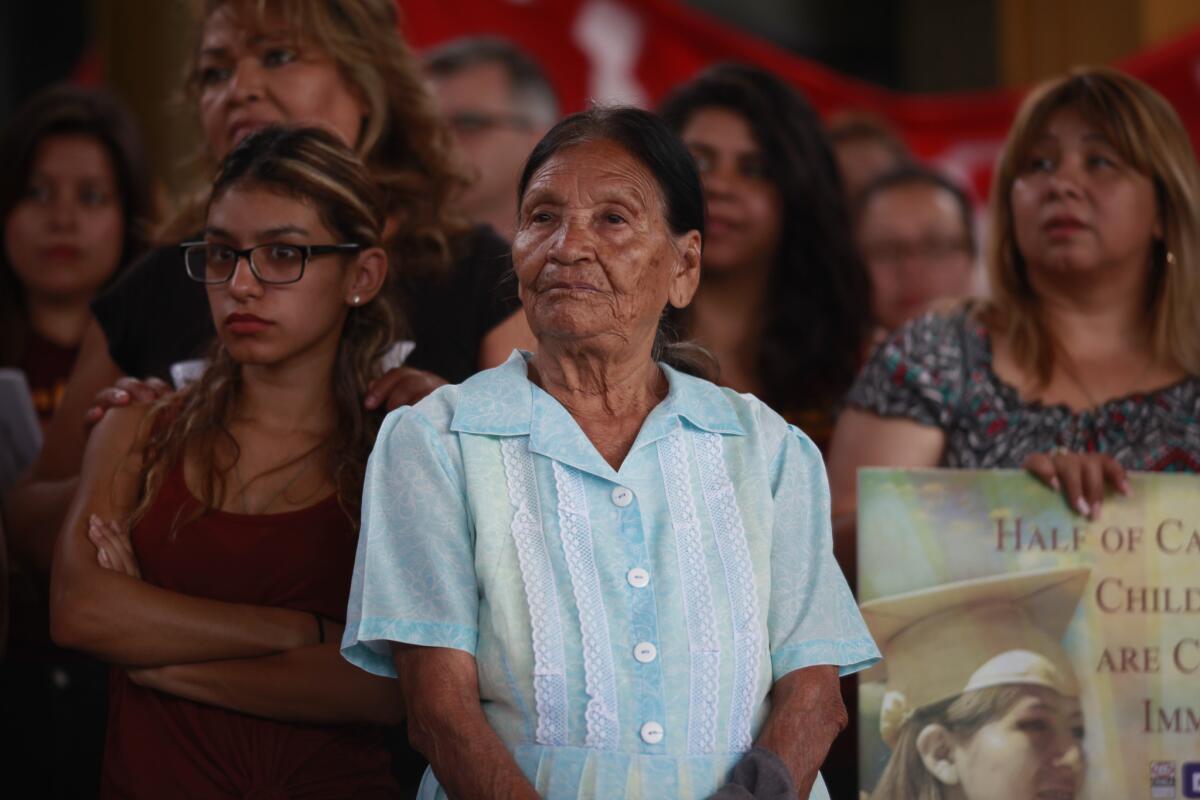The Latino vote is bigger and better educated than ever before, a new report finds

Rosalia Garcia de Flores, center, listens with others at a news conference in Pacoima launching a campaign to register Latino voters in mixed-status families. The number of Latinos eligible to vote in this year’s presidential election is 40% higher than it was just eight years ago, according to a new report by Pew Research Center.
The Latino electorate is bigger and better educated than ever before, according to a new report by Pew Research Center.
It’s also young. Adults age 18-35 make up nearly half of the record 27.3 million Latinos eligible to vote in this year’s presidential election, the report found.
But although the number of Latinos eligible to vote is surging -- 40% higher than it was just eight years ago -- and education levels are rising, the percentage likely to actually cast ballots in November continues to lag behind other major racial and ethnic groups, the report found.
Join the conversation on Facebook >>
That’s partly because young people don’t vote as consistently as older people do, but also because Latino eligible voters are heavily concentrated in states -- including California, Texas and New York -- that are not prime election battlegrounds.
The report analyzing the Latino electorate sheds new light on an increasingly important voting bloc that both Republicans and Democrats hope to capture as the overall pool of eligible voters becomes less white.
In 1986, 82% of Americans eligible to vote were white. The percentage has declined steadily and hit 70% by 2014. Over the same period, the share of eligible voters who are Latino has risen from 5% to 11.4%, the report noted.
The share of blacks among eligible voters increased from 11% to 12.1% during that time. The Asian share increased from 1.4% in 1990 to 4.2% in 2014.
The explosive growth of the Latino electorate is largely driven by young people born in the U.S. Between 2012 and November of this year, about 3.2 million U.S.-citizen Latinos will have turned 18 and become eligible to vote, according to the report’s projections.
SIGN UP for the free Essential Politics newsletter >>
Millennials -- adults born in 1981 or later -- will account for 44% of the Latino electorate by November, according to the report. By comparison, millennials will make up only 27% of the white electorate, the report found.
The number of Latino potential voters is also being driven by immigrants who are in the U.S. legally and decide to become U.S. citizens. Between 2012 and 2016, some 1.2 million will have done so, according to the report.
Although most new voters are not immigrants, a majority of Latino voters have a direct connection to the immigrant experience, the report noted. That’s an important fact in an election cycle that has been dominated by debates over what do with the estimated 11 million immigrants who entered the U.S. without authorization.
By November, 56% of the Latino electorate will be made up of immigrants or the U.S.-born children of immigrants, here with authorization or without. That’s up from 51% in 2000, according to the report.
As native-born young people make up a greater share of the Latino population, those eligible to vote in November will have higher levels of education than in any recent presidential election year, the report found. Compared to 2000, eligible Latinos will be nearly twice as likely to have at least some college education.
Rising education levels typically would lead to greater turnout, but other factors of youth and geography have held turnout down, the report found.
Fifty-two percent of the nation’s voting-eligible Latinos live in California, Texas or New York, states that don’t have early primary elections and have not been up for grabs in presidential elections for many years.
“Many Hispanics live in states that haven’t necessarily been battlegrounds,” said Mark Lopez, the director of Hispanic research at Pew. “That means these Hispanics, whether they’re older or younger, just aren’t going to be targeted by voter outreach efforts in the ways they would if they lived in more competitive places.”
Latinos make up fewer than 5% of eligible voters in just about every state with close elections.
The exceptions are Florida, Nevada and Colorado, the report found. In each of those states, Latinos make up more than 14% of eligible voters. That’s why presidential campaigns on both sides of the political spectrum have been targeting their Latino outreach efforts there.
For more news on the presidential campaign and the growing Latino electorate, follow me on Twitter: @katelinthicum
ALSO
‘Affluenza’ attorney: Was Texas teen taken to Mexico against his will?
Obama still might lose on immigration, no matter how the Supreme Court rules
Congressional Budget Office: Economy grows, but so does deficit, thanks to tax breaks
More to Read
Sign up for Essential California
The most important California stories and recommendations in your inbox every morning.
You may occasionally receive promotional content from the Los Angeles Times.











